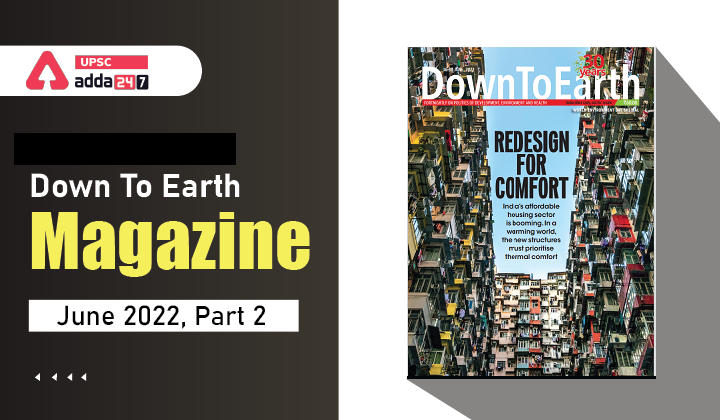Table of Contents
Down To Earth is a fortnightly magazine focusing on politics of environment and development, published in New Delhi, India.
UPSC Previous years’ questions on Development, Environment, Health and Disaster Management give us a clear idea about the increased importance of DTE magazine.
DTE Magazine is one of the most important and indispensable source for UPSC Civil Services Exam Preparation. Keeping this in mind, here, we come with ”Gist Of Down To Earth Magazine” which covers important environmental current affairs articles in smooth pointed form, keeping in mind the demand of UPSC aspirants.
ENERGY EFFICIENCY V THERMAL COMFORT: Introduction
- India’s energy efficiency codes for commercial and residential buildings for energy savings are evolving.
- Currently, building related energy efficiency policies and building codes are designed to promote energy-efficient cooling technologies and heat resilient building materials and walling systems for energy savings. But such measures do not necessarily improve thermal comfort hours.
- ICAP has mandated thermal comfort standard for buildings. It is however challenging to regulate thermal comfort as people’s perception of comfort varies widely
- So a lot more is needed to promote adaptive thermal comfort in buildings.
ENERGY EFFICIENCY V THERMAL COMFORT: What is Thermal comfort standard?
- Thermal comfort standard is not an exact science but a set of requirements within a climatic context and activity of people that reduce the impact of outdoor conditions on interior without air conditioning as much as possible. This is not a prescription but an approach.
- The Ministry of Housing and Urban Affairs in collaboration with German government as part of the Indo-German Energy Programme is currently working on a thermal comfort action plan 2050 and thermal comfort standards cum guidelines to enhance thermal comfort in affordable housing in India under the Climate Smart Buildings programm.
ENERGY EFFICIENCY V THERMAL COMFORT: Existing Codes
ENERGY EFFICIENCY BUILDING CODE FOR COMMERCIAL BUILDINGS
- The Energy Conservation Building Code (ECBC) of 2007 for commercial buildings when revised in 2017 increased emphasis on the use of passive architectural design.
- For instance, the maximum value for window-to-wall ratio in a building was reduced from 60 to 40 per cent to control the excessive use of heat-trapping glazing surfaces.
- Insulation values of both the walling materials and roofs were made more stringent. These measures increased the scope for passive architectural design and material choices for compliance with the code.
- It pushed for better rating than just minimum compliance and stratified the options as ECBC compliant, ECBC + and Super ECBC compliant building.
- The ECBC Rules 2018 has incorporated post-occupancy performance that was ignored earlier.
- Building owners now have to submit an energy performance index report for two consecutive years after fully operating the building.
- If the desired energy performance is not achieved, the necessary changes are required within three years for compliance. Only 12 states and Union territories have notified the code and another 12 have incorporated ECBC 2017 in their municipal building by-laws.
ECO NIWAS SAMHITA FOR RESIDENTIAL BUILDINGS 2018
- This code is for energy efficiency improvement in residential sector and is meant for 500 sq m and larger sites. The code lays emphasis on passive design features, including building orientation, material choices and shading devices. This is not yet mandatory. A few states have included this in their by-laws.
- Eco Niwas Samhita needs to improve further. For example, the code calculates heat gain and visual light transmittance in an individual building but does not factor in the impact of surrounding buildings on heat transfer and daylight penetration.
- The focus is on thermal transmittance or U-value which is an insulation property and not thermal mass property of materials. This may not always deliver better thermal comfort. Materials with higher thermal mass deliver better thermal comfort despite a lower U-value like compressed stabilised earthen blocks.
ADAPTIVE THERMAL COMFORT MODELS
- In 2016 the National Building Code (NBC) included naturally ventilated, air conditioned, and mixed-mode buildings within its adaptive comfort model.
- In mixed-mode buildings people can be more adaptive to a wider range of temperature and flexibly operate cooling devices according to requirements for greater energy savings.
- NBC expanded the comfort limit range to tropical summer index values between 19o C and 34o C.
- But air conditioned buildings can operate within a smaller range and with lower upper limit.
- Going forward thermal comfort standards must create conditions for more bioclimatic controls in all buildings to minimise air-conditioned hours.



 TSPSC Group 1 Question Paper 2024, Downl...
TSPSC Group 1 Question Paper 2024, Downl...
 TSPSC Group 1 Answer key 2024 Out, Downl...
TSPSC Group 1 Answer key 2024 Out, Downl...
 UPSC Prelims 2024 Question Paper, Downlo...
UPSC Prelims 2024 Question Paper, Downlo...
